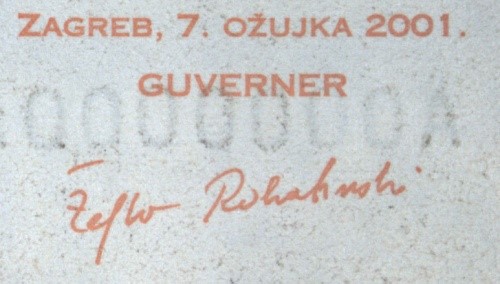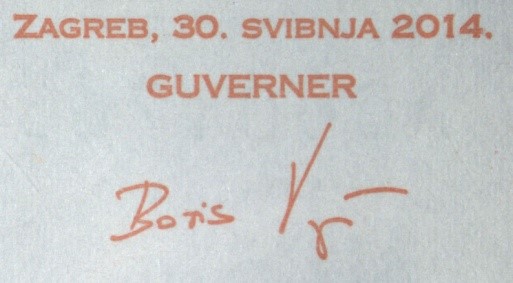The first series of kuna banknotes was issued in the denominations of 5, 10, 20, 50, 100, 200, 500 and 1000 kuna, with the date of issue 31 October 1993.
Name of the monetary unit
The name of the monetary unit the kuna comes from the Croatian word for marten, an animal living in the Croatian woods, whose pelts were used as a means of trade, that is, functioned as money.
Motifs on the obverse and reverse of the banknotes
The banknote design is by Miroslav Šutej, Šimun Šutej and Vilko Žiljak. Each banknote has its main colour. The obverse of the banknotes features a leading figure of Croatian history and culture, while the 5 kuna banknote bears an image of two Croatian noblemen related by blood. The reverse of all banknotes shows a panorama or a typical Croatian town motif.
5 kuna banknote
Main colour: green
Obverse: Petar Zrinski and Fran Krsto Frankopan
Reverse: Varaždin Castle
10 kuna banknote
Main colour: purple
Obverse: Juraj Dobrila
Reverse: Arena in Pula
20 kuna banknote
Main colour: orange-red
Obverse: Josip Jelačić
Reverse: Vučedol dove and the Caste of Count Eltz in Vukovar
50 kuna banknote
Main colour: blue
Obverse: Ivan Gundulić
Reverse: Dubrovnik
100 kuna banknote
Main colour: light brown
Obverse: Ivan Mažuranić
Reverse: Church of St. Vitus in Rijeka
200 kuna banknote
Main colour: brown
Obverse: Stjepan Radić
Reverse: building of the general headquarters in Osijek, 1726
500 kuna banknote
Main colour: greenish
Obverse: Marko Marulić
Reverse: Diocletian's Palace in Split and the figure of a Croatian ruler
1000 kuna banknote
Main colours: red and blue
Obverse: Ante Starčević
Reverse: monument to King Tomislav and the Zagreb cathedral
The banknotes' appearance and features have been slightly altered over the twenty years that they have been in use: the 10 kuna banknote's main colour has been changed to grey and most of the banknotes have been improved by new security features. Therefore, in addition to the issues from 1993, the improved 2001, 2004 and 2012 and 2014 issues are now also in circulation.
Signatures on the banknotes
The date of issue of the banknote and the facsimile signature of the Governor are printed on the reverse of the banknotes, in the upper right corner. Valid kuna banknotes may bear the signatures of Pero Jurković and Željko Rohatinski, the former Governors, or of Boris Vujčić, the current Governor of the Croatian National Bank. Notwithstanding the signature they bear, all banknotes have the same value.



